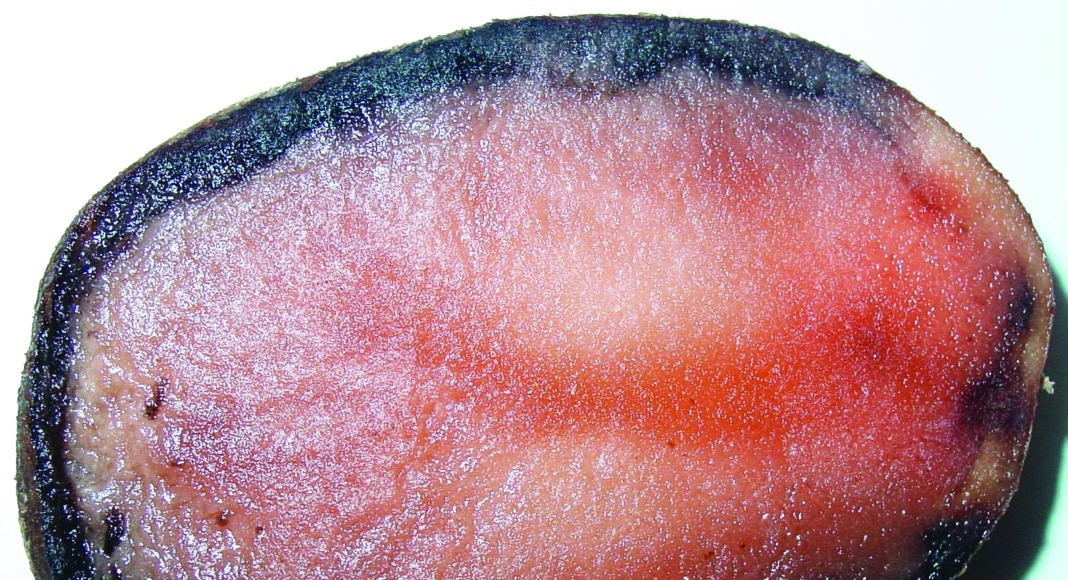While growers across Canada will have a number of pests and diseases targeting potatoes in their specific regions, they all may face one common foe — PED.
Potato diseases such as early or late blight can occur in any of the potato growing regions of Canada. And as every grower knows, these, and many other disease and pest issues are weather related, but one disease becoming of increasing concern across the whole country is potato early dying (PED).
In Manitoba, early dying complex (caused by Verticillium and black dot) has become endemic, and in Atlantic Canada it’s number two, right behind late blight. Warm and dry conditions, which have plagued Canada in recent years, stress potato crops and make them more prone to early dying complex.
“Black dot disease is becoming more important and the surface blemish impacts the process quality and also marketing of fresh potatoes,” says Vikram Bisht, with Manitoba Agriculture and Resource Development (MARD).
Early dying is becoming such a serious issue that a number of researchers and scientists from across Canada have established the national, Canadian Potato Early Dying Network (CanPEDnet), working on various aspects of PED. Agriculture & Agri-Food Canada (AAFC), through its potato cluster, has provided funding for the network, which aims to develop and evaluate model approaches for control, spoil and plant testing and monitoring of PED and develop strategies to control it through novel products, crop rotation, suppressive crops, and increasing and maintaining biodiversity.
Manitoba Could Suffer from Wet Spring Soils
Based on potentially saturated soils in spring 2020, there could be blackleg and/or soft rot related emergence issues in Manitoba fields where drainage is poor.
“If the soils stay cooler, there could be slow emergence and increase the proneness to tuber rotting,” says Bisht.
Depending on the weather conditions, late blight, early blight, botrytis and white molds may become an issue for Manitoba and western Prairie potato growers in 2020, says Bisht. “Most growers have a good fungicide program — it is a matter of timing the applications.”
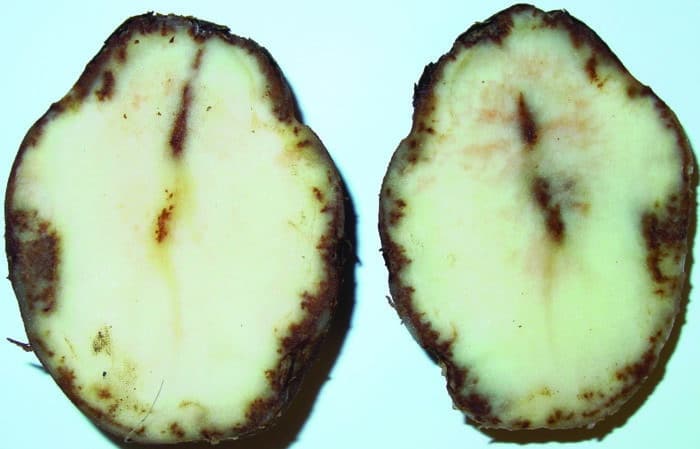
A good spray program along with dry macro-weather were responsible for no late blight in 2019, but late blight is still one of the most important diseases growers have to be ever vigilant about, says Bisht. With a network of weather stations, MARD provides late blight disease risk forecasts on a regional level. The late blight risk increases when the weather is generally moist or wet.
“It is difficult to forecast for specific fields due to highly variable geo-environmental conditions, but every year there are periods of high risks for late blight, especially in low lying spots and wind-protected areas and after thunderstorms, when inoculum can travel many kilometers,” says Bisht. “It is important to scout for the disease in low lying spots and areas close to tree lines or under high tension hydro-power lines, where aerial application of fungicides is difficult.”
Slow emergence due to cool soils could also have been responsible for higher than normal blackleg and bacterial stem rot incidence in many Manitoba fields last year, while warm and wet conditions at harvest meant many potatoes had pink rot infection, which was partly responsible for some rotting in storage.
Growers should scout regularly for crop health and pest issues with Bisht recommending they follow the late blight risk forecast, which is posted online at www.mbpotatoes.ca.
“Based on late blight risk forecasts the frequency of fungicide applications could be extended, saving on costs and reducing pesticide usage, or shortened when the risk is high,” says Bisht. “We also post other disease and insect monitoring reports on this site.”
It’s also important to confirm the cause of any unrecognized pest issue and samples, which can be sent to the Manitoba Crop Diagnostic Centre in Winnipeg, Man. for diagnosis.
Look Out for Colorado Potato Beetle and Aphids
Normally, during warm and dry conditions, insect populations become an issue — surprisingly though, the levels of various insect pests was low last year in Manitoba.
“In potato crops, we conduct monitoring surveys for European corn borer, aphids (seed potato crops) and aster leafhoppers. In 2019, we found low levels of these pests,” says Bisht.
“Colorado potato beetles continue to be an insect pest of concern in some areas of the province, mainly due to occurrence of populations resistant to commonly used insecticides,” says Bisht. “The review of group 4A insecticides is another sword hanging on loss of options for CPB control.”
European corn borer (ECB) could continue to be a minor pest on potatoes. Bisht is one of the researchers involved in a new, national monitoring program for ECBs in corn and potato crops under the Canadian Food Inspection Agency Plant Health Initiative and Surveillance Program.
Aphid monitoring on seed potato crops will continue, says Bisht. “Aphids are efficient vectors of potato viruses from plant to plant, and could eventually affect the seed potato quality,” he says. “Often there is an influx of the aphids and leafhoppers with winds from the south.”
Atlantic Canada Growers Should Think About Blight Management
In Atlantic Canada dry conditions resulted in some incidences of early blight during last year’s growing season, but low moisture and a lack of inoculum meant diseases like late blight were absent. In areas with abundant rain during harvest though, some storage diseases such as Pythium leak, pink rot, dry rot and soft rot, were found.
For 2020, these diseases could cause issues during the growing and storage seasons, says Khalil Al-Mughrabi, pathologist at the Potato Development Centre with the New Brunswick Department of Agriculture, Fisheries and Aquaculture.
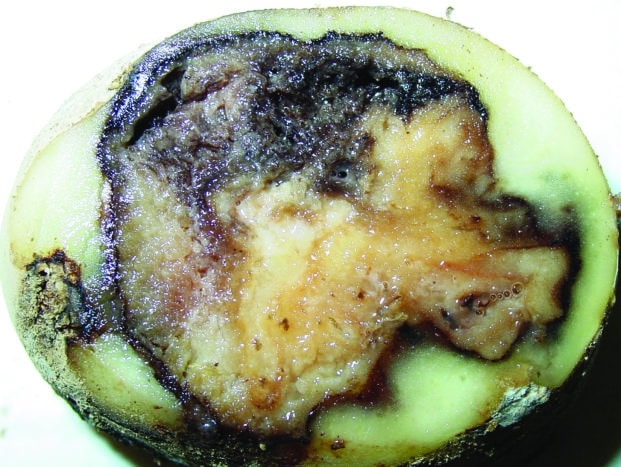
“If weather conditions change and become conducive to late blight disease, this disease can re-establish itself very quickly,” he says. “We have been warning growers in New Brunswick to stay vigilant and not to let their guards down when it comes to protecting their crops against late blight.”
Cool nights and warm days, with relative humidity in excess of 90 per cent are conditions are favourable for late blight development if the inoculum is present.
Good late blight management begins with planting disease-free seed, Al-Mughrabi says. Growers should inspect seed potatoes within 24 hours of delivery by cutting a sample of tubers and look for reddish brown dry rot, which is a characteristic of late blight tuber rot.
When growers purchase seed, Al-Mughrabi recommends they have it tested for the absence of blighted seed by an authorized provincial service in their region. Growers should grade seed potatoes after being cut to remove any late blight infected tubers which can be a potential source of early infections in the field. They should also disinfect seed cutting equipment frequently and immediately after cutting, treat seed with a recommended mancozeb-based seed piece fungicide.
Managing Early Blight
For early blight to occur, alternating dry and wet weather conditions stresses plants and triggers the disease. To avoid early blight infection, Al-Mughrabi suggests growers’ plant resistant varieties, use blight free seed and destroy potential sources of inoculum such as cull piles and volunteer plants.
If conditions are favourable for early blight, growers should start a fungicide spray program early, before rows fill in, following provincial recommendations, Al-Mughrabi says. Vines should have been dead for at least two weeks before harvest to permit tubers to mature, and care should be taken to avoid bruising in handling. Any tubers left on the surface of the field should be left to freeze and not disked or plowed under.
Balancing fertilizer is important to prevent delayed maturity or increase susceptibility to early blight. Petiole analysis for nitrate content can be helpful in regulating fertilizer rates. A storage environment which allows rapid suberization and wound healing immediately after harvest will reduce tuber infection, Al-Mughrabi says. Once tubers are infected, warm conditions favour decay, while cool conditions slow the rate of disease development.
P.E.I. May See Some Familiar Insects and Diseases
The main pest Prince Edward Island growers need to lookout for in 2020 are Colorado potato beetles (CPB), aphids, European corn borer and flea beetles, says Christine Noronha, an entomologist with AAFC.
“Conditions such as early and warmer than usual temperatures in the spring could result in insects becoming active earlier resulting in movement into the crop,” she says.
Last year was a quiet season on the insect front, says Noronha. “We had low aphid numbers, CPB were effectively controlled, and we had average numbers of tarnished plant bug and flea beetle and European corn borer damage.”
Wireworm has been an issue in several parts of the province for several years, but damage levels haven’t been as severe in the last couple of years due to a combination of weather conditions, proactive management decisions by growers, and new best management practices developed through local research, says Ryan Barrett, research coordinator with the P.E.I. Potato Board. “Potato early dying, common scab, and blackleg are all common diseases that are exacerbated by weather conditions and tend to vary from year-to-year.”
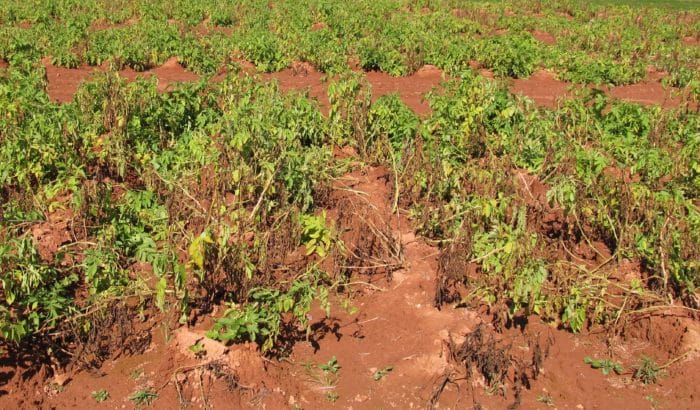
It’s likely the same pests will show up this year, although numbers will depend on how the spring and summer shapes up. “A not very cold winter may see high survival and if this is followed by a warm moist spring it could result in earlier emergence and higher egg and larval survival,” says Noronha. “In addition, if the spring is warm, eggs will be laid in a shorter period of time, resulting in more individuals being at the damaging life stage earlier in the season.”
So far, winter has been mild in the Maritimes with very few days when the temperature dropped to below -15 C, which could result in higher survival of the pest species and insects in general.
The main thing growers need to do is keep an eye on the weather and temperatures in the spring, begin scouting early and use degree days to determine potential emergence of the pest in order to know the best time for control intervention, advises Noronha.
P.E.I. Growers Embracing Adaptive Management Practices
High priority diseases from recent years, including PED, common scab, blackleg (Pectobacterium spp.) and Alternaria spp. (solani and alternate), will plague potatoes again this year according to a recent survey of plant diagnostic services done by P.E.I.’s Department of Agriculture and Land, says Lorraine MacKinnon, the Department’s potato industry coordinator.
Last year was dry in July and most of August in the region, before being excessively wet for September and October. Foliar diseases like late blight, brown spot and early blight were either non-existent or mild. The winter of 2018/2019 saw a lot of freezing and thawing throughout it, which eliminated a lot of volunteers and reduced seed-borne disease inoculum.
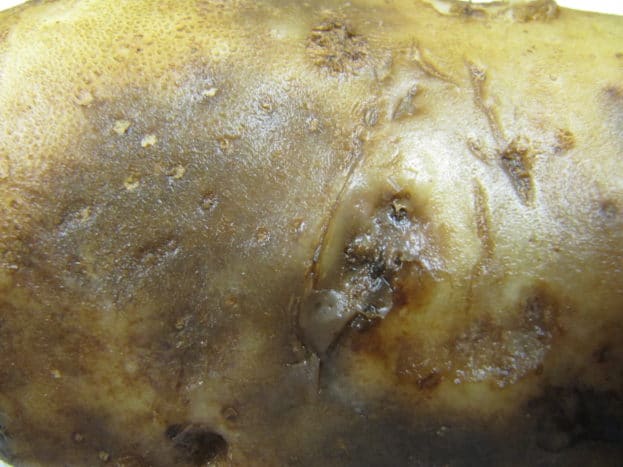
A number of P.E.I. growers are now employing management software to predict pest and disease risk in order to target pest management practices, says Barrett. “For many diseases, planting clean seed with proper preventative seed treatments is a key to preventing diseases and pest issues later in the growing season,” he says.
“Most island growers are aware of the local research that has been underway regarding pest management on some of the most common pest and diseases and are adapting production practices or crop rotation to minimize their risk. For example, we are seeing a large number of potato growers adapt their crop rotation to include species like brown mustard, sorghum sudangrass or forage pearl millet to battle Verticillum and root lesion nematodes.”
Late Blight Look-Alike Could Be on its Way to Ontario
Late blight remains a top threat for Ontario growers with vigilance in field scouting and preventative fungicide applications required, says Dennis Van Dyk, vegetable crop specialist with the Ontario Ministry of Agriculture, Food and Rural Affairs.
A new late blight strain, US-25 was detected next door in New York State in 2018 so sending late blight for strain identification is very important, adds Van Dyk.
Another thing Ontario is keeping an eye on is a late blight look-a-like, Phytophthora nicotianae, which is a related species to the late blight pathogen P. infestans. This is more of a soil-borne disease but can exhibit similar foliar symptoms to late blight and was found in North Carolina in 2018, and New York and Pennsylvania in 2019.
“Luckily Ontario did not have a major outbreak of late blight in 2019 so there were no real signs of late blight or its look-a-like,” says Van Dyk.
Late blight is an annual concern in Ontario and the late blight spore trapping network across the province has been critical for helping growers to stay ahead of this disease and utilize their fungicides preventatively.
With Dickeya blackleg being an emerging seed potato concern, growers should continue to prevent infected seed lots from being planted.
Long-Term Resistance Plan Needed for CPB
CPB resistance is once again on the radar in Ontario. Neonic seed treatments still provide good control of CPB but recent resistance testing by AAFC has shown a growing tolerance to these insecticides in some populations.
“A long-term resistance management program is going to be key for continuing control of CPB, especially in the face of potential use cancellations,” says Van Dyk.
Ontario has had a relatively mild winter which often means higher disease and insect pressure the following year. “We are also anticipating a higher survival of volunteer potatoes which are potential sources of late blight,” says Van Dyk. “Hopefully the mild winter means that growers will be able to get an early start on planting as opposed to 2019, but of course it’s still too early to tell.”
Field scouting is a critical part of pest management, emphasizes Van Dyk. “Know what’s going on in your fields and adjust your management accordingly,” he says. “Know your pesticide groups and have a resistance management plan in place, especially when it comes to late blight and CPB. When late blight has been confirmed in your area or the risk is high, ensure you’re applying late-blight specific fungicides.”

